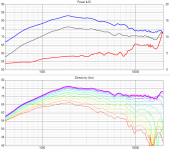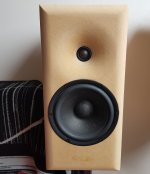Maybe it has some sense to look at this Scanspeak tweeter, combined with the 3 inch midrange.
We can compare off axis responses of both and look to the total power response.
Tweeter – Scan-Speak A/S
A good test here:
Test Scan-Speak Discovery H2606 / 920000 – Heissmann Acoustics
Its waveguide is not so large, maybe it fits well with a 3 inch dome midrange.
We can compare off axis responses of both and look to the total power response.
Tweeter – Scan-Speak A/S
A good test here:
Test Scan-Speak Discovery H2606 / 920000 – Heissmann Acoustics
Its waveguide is not so large, maybe it fits well with a 3 inch dome midrange.
Last edited:
Why there are no Volt woofers included?
Also, for the tweeter, I would take as first consideration SB Satori soft dome (as it is exchangable to Berrylium version usually without crossover change) and it is one of the highest regarded tweeter today.
Also, for the tweeter, I would take as first consideration SB Satori soft dome (as it is exchangable to Berrylium version usually without crossover change) and it is one of the highest regarded tweeter today.
... What about the Faital HF108?
Together with a suitable horn it should be one of the better options available. Only need to pad it down a little. Distortion figures should be ridiculously low since you only need a fraction of a watt to get really loud.
Edit:
And the Faital 6PR150 looks nice enough from ca 400hz up? has high qms too. How about an all Faital build? It would probably make it easier for people to order parts too, all from the same place.
I apologize for increasing the potential of confusion.
Together with a suitable horn it should be one of the better options available. Only need to pad it down a little. Distortion figures should be ridiculously low since you only need a fraction of a watt to get really loud.
Edit:
And the Faital 6PR150 looks nice enough from ca 400hz up? has high qms too. How about an all Faital build? It would probably make it easier for people to order parts too, all from the same place.
I apologize for increasing the potential of confusion.
Last edited:
Copied from the open source waveguide thread:
The Bliesma tweeters look very nice!
However, the Volt VM752 starts beaming a bit earlier than most 3" drivers, see audioXpress measurements, 3 dB down at 2.5kHz/30 deg. The Bliesma is nearly at full level at this point, so not a good match in terms of directivity. I am still thinking of waveguides...
Well, as you ask... <snip>
The Bliesma tweeters look very nice!
However, the Volt VM752 starts beaming a bit earlier than most 3" drivers, see audioXpress measurements, 3 dB down at 2.5kHz/30 deg. The Bliesma is nearly at full level at this point, so not a good match in terms of directivity. I am still thinking of waveguides...
Last edited:
I have the 6600 and 6640 at home, but am away for a few days. Also a R2904/7000 somewhere, will have to check. What do you have in mind?Anyone have an actual measurement of the 1" Scan's surround diameter?
38mm is tight fit (WG148R Visaton for example), My mdf prototypes have 40mm, counting with some paint thickness.
Anyone have an actual measurement of the 1" Scan 2904/7000 surround diameter?
mbrennwa> I could whip a design for you to play with if you wanted
Pida> this is a ring radiator you're referring too? I have a hunch they are smaller diameter than the domes?
Pida> this is a ring radiator you're referring too? I have a hunch they are smaller diameter than the domes?
mbrennwa> I could whip a design for you to play with if you wanted
Great! Does that mean you think there is potential ro make them R2904/7000 work well im a waveguide? Would you need the driver to make the waveguide fit? I could borrow a R2904/7000, but would have to check where they are in the basement when I am back home.
They are all same (outter circumference of the surround), 6600, 7000, 7100, I had all of them physically mounted in WG148R and my WG.
R2004 and D2004 need 29-30mm, and again, they are same.
R 7000 in WG measurement is in the attachment, it is WG170mm, prototype, profile is not exactly what it should be as carpenter sanded too much. I should have new prototypes soon. Anyway, I hope it shows some potential for your application and development of your WG.
R2004 and D2004 need 29-30mm, and again, they are same.
R 7000 in WG measurement is in the attachment, it is WG170mm, prototype, profile is not exactly what it should be as carpenter sanded too much. I should have new prototypes soon. Anyway, I hope it shows some potential for your application and development of your WG.
Pida> this is a ring radiator you're referring too? I have a hunch they are smaller diameter than the domes?
Attachments
Last edited:
How did you fit the WG148 to the Scanspeak?
Measurements look promising. What was the drive voltage and mic distance (--> sensitivity?) Baffle dimensions?
Measurements look promising. What was the drive voltage and mic distance (--> sensitivity?) Baffle dimensions?
Measurement conditions:
- drive voltage not specified, I estimate ~2V
- mic distance 1m
- gatting window 3.6ms
- no smoothing
- measured in cabinet in the attachment, 220x460mm
To mount these scanspeaks to WG you have to remove the faceplate and make the saddle for tweeter which also centers it.
- drive voltage not specified, I estimate ~2V
- mic distance 1m
- gatting window 3.6ms
- no smoothing
- measured in cabinet in the attachment, 220x460mm
To mount these scanspeaks to WG you have to remove the faceplate and make the saddle for tweeter which also centers it.
Attachments
mbrennwa> it would be best to have one in-hand so I can make sure the design fits
Pida> You mentioned 38mm and 29-30mm, which is correct? 30mm would be promising. The 6600 family is not that small is it?
Pida> You mentioned 38mm and 29-30mm, which is correct? 30mm would be promising. The 6600 family is not that small is it?
38mm throat diameter for R3xxx and D3xxx family (and R29xx) = 1" domes and ring radiators (6600, 7000, 7100) 29-30mm for R2xxx and D2xxx family = 0.75" domes and ring radiator (D2004/6020, R2004/6020)
Pida> You mentioned 38mm and 29-30mm, which is correct? 30mm would be promising. The 6600 family is not that small is it?
Last edited:
Ok, thats a bit more involved than the simple kitchen table approach that we have in mind to make the Monkey Coffin "novice friendly". But maybe the WG148 can be adapted to the Scan using easier tools, a bit like what I did here using the Monacor WG300. If a custom 3D printed waveguide is possible, that might be best.Measurement conditions:
- drive voltage not specified, I estimate ~2V
- mic distance 1m
- gatting window 3.6ms
- no smoothing
- measured in cabinet in the attachment, 220x460mm
To mount these scanspeaks to WG you have to remove the faceplate and make the saddle for tweeter which also centers it.
How deep should the waveguide be? Would it make sense to align the voice coils of the tweeter and the midrange?
There are companies online providing different methods of 3D printing services (along w laser cutting, engraving ...) if one does not have direct access to a 3D printer.
I worked w Sculpteo before, very helpful and very affordable and also quick !
I worked w Sculpteo before, very helpful and very affordable and also quick !
If the result of tweeter/WG combo is close to constant directivity, and dispersion is same for the midrange at crossover frequency, in that case I found LR4/LR4 more suitable. It results in almost perfect power response (based on horizontal measurement). Of course, when vertical response is included into equation, power response and DI have dip/bump at the crossover frequency.
For XT25 in WG300 + P17RCY I used LR2/LR2 which created smooth mid to tweeter transition, but for this combo DI is monotonically rising.
In both cases it is benefical to have tweeter acoustic center roughly aligned with midrange. It makes crossover modelling and obtaining good phase tracking easier.
For XT25 in WG300 + P17RCY I used LR2/LR2 which created smooth mid to tweeter transition, but for this combo DI is monotonically rising.
In both cases it is benefical to have tweeter acoustic center roughly aligned with midrange. It makes crossover modelling and obtaining good phase tracking easier.
How deep should the waveguide be? Would it make sense to align the voice coils of the tweeter and the midrange?
Ok, here's how I see this... D.A.S. and Faital woofers and Volt VM752 mids are all ordered. Once I have them, I will do various measurements (as described in an earlier post). The directivity of the VM752 will tell us how to match the tweeter. If these data still show the same directivity as the aX measurements (I would be surprised if they didn't), we can go ahead an design a suitable waveguide/tweeter combination. Otherwise the Satori tweeter as in Pauls simulation study seems a good choice to me.mbrennwa> it would be best to have one in-hand so I can make sure the design fits
What do you guys think?
If you use a robust tweeter that can cross down 2khz or less, you probably won't need a waveguide with the Volt. I was just under the impression you guys wanted to cross higher.
- Home
- Loudspeakers
- Multi-Way
- Open Source Monkey Box

